Ever watched an orange cat in action and found yourself amused by their bold and seemingly eccentric conduct?
It’s no surprise that these ginger furballs frequently catch our eye and our hearts. (1)
With their sunset-hued coats and lively personalities, orange cats certainly stand out in the feline crowd. But have you ever wondered why they seem more spirited or “crazy” compared to other cats?
If so, you’re not alone; the quirky behavior of these felines is a curiosity for many pet lovers.
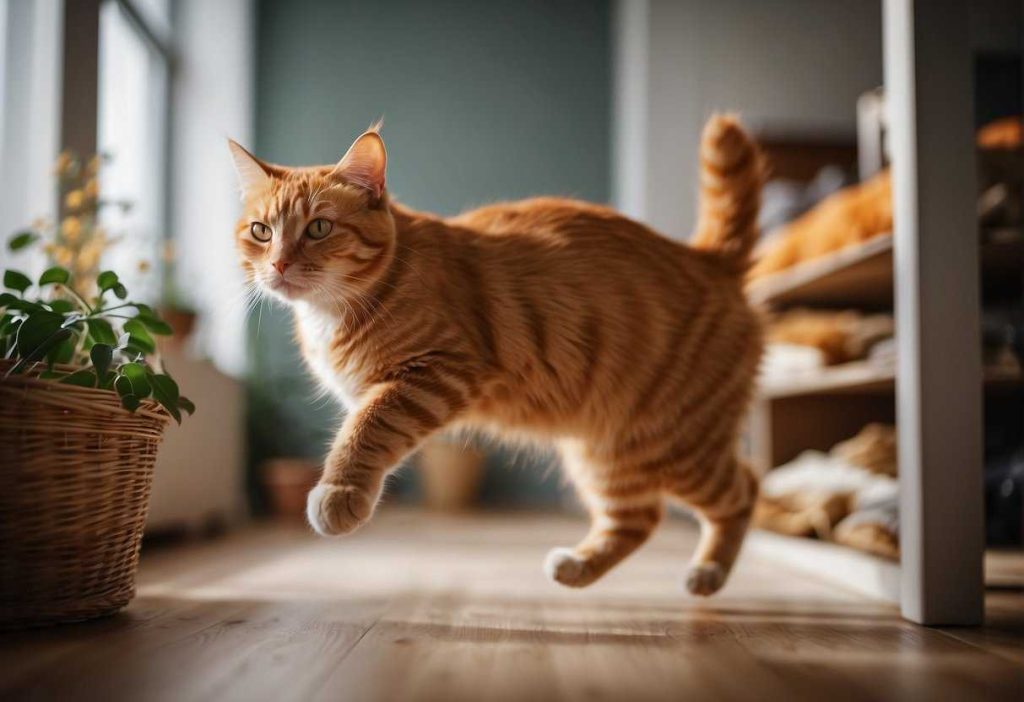
The notion of orange cats being especially “crazy” is intriguing and often laced with humor, leaving many cat owners and enthusiasts pondering the truth behind this perception.
This article seeks to sift through the anecdotes and explore the behaviors commonly associated with orange cats.
We’ll tap into scientific findings, debunk some myths, and offer practical tips for living with these vivacious companions.
If you’re an orange cat owner, you’ll find strategies here to reinforce your bond and ensure the well-being of your playful pal, including understanding the role of their collective brain cell.
Key Takeaways
- Orange cats have a reputation for being lively and affectionate.
- The personalities of orange cats can be influenced by genetics.
- Owners may foster a positive relationship with understanding and proper care.
Understanding Why Are Orange Cats So Crazy?
Have you ever been mesmerized by the fiery fur of an orange cat? These bright felines are instantly recognizable, thanks to their vivid coat color, which is all thanks to genetics.
The coat color of orange cats is the result of a pigment called pheomelanin, the same pigment that gives redheads their distinctive hair color.
It’s the high levels of pheomelanin that produce that vibrant orange hue we all adore.
Interestingly, the gene responsible for this coloration, known as the O gene, is found on the X chromosome, specifically in the domestic cat Felis catus. (2)
Now, if you’ve thought all ginger cats are male, that’s not quite true.
While it is more common for orange cats to be male, due to genetics requiring only one copy of the O gene for males (XY) and two for females (XX), female cats can also sport the orange coat.
Female orange cats are less frequent but just as enchanting, and they are often born with unique coat patterns such as calico or tortoiseshell.
When it comes to the classic “orange cats are crazy” myth, let’s set the record straight. Coat color, including that delightful orange, doesn’t scientifically affect a cat’s personality.
While individual orange cats may have a range of behaviors, no proof links their coat color to wacky antics.
A study from Berkeley Research found that orange cats were characterized as friendly, while black cats, white cats, and tri-colored cats were seen as more antisocial.
It’s just a fun stereotype that’s found its way into the collective conscious, thanks in part to viral internet fame.
- Common Myths about Orange Cats: They are all male: Not true!
- Orange coat equals crazy behavior: No proven correlation!
So, what’s the takeaway about the charm of orange cats?
Their bold color may catch your eye, but it’s their unique personalities, known for their friendliness and lack of aloofness and shyness, that will capture your heart.
Remember, it’s the individual feline’s quirks and habits that make them your special companion, not their coat color.
Whether snuggling up with you or chasing shadows, each orange cat is full of their own brand of magic.
Deep Dive into Orange Cat Behavior
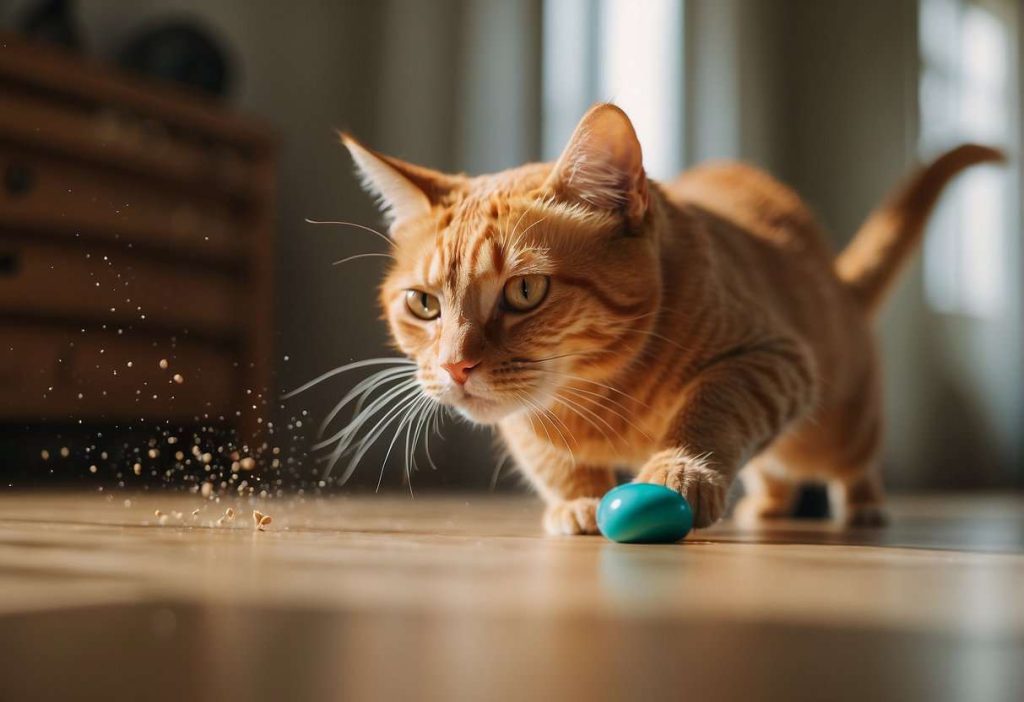
The Science of ‘Craziness’
Curiosity got the best of you, eh? Studies haven’t conclusively linked coat color to behavior, but many pet parents swear their orange furbabies are a tad more gregarious and playful.
Might this be a quirky coincidence of genetics? Perhaps their environment plays a part? Or maybe their tendency to be affectionate is just their way of winning us over!
Further research is needed to understand the potential role of personality differences in cats and how they may be influenced by genetics, environment, or other factors.
Decoding Cat Psychology
So, about behavior and personality—orange cats break the mold. Both male and female orange cats often exhibit a certain charisma that translates to their human interactions. If you’ve got one, you know they’re:
- Chatty (vocalization on point!)
- Zestful (a fancy word for overflowing with playfulness)
While cat behavior varies, these marmalade mischief-makers could teach us a thing or two about zest for life.
Behavioral Insights and Misconceptions
Having an orange tabby and finding life less cat-astrophic? There’s a reason for that! Their affectionate nature and tendency to socialize can bring down stress levels.
But remember, vocalization isn’t them being crazy; they might just be trying to tell you about their day! (3)
Body Language and Signals
Let me guide you through some signals your orange buddy might be sending:
- Tail high in the air? That’s a sign of confidence!
- Purring galore? Affection-meter is off the charts!
- A mix of meows and chirps? They’re simply “talking” to you.
Grab your detective hat and next time, you’ll be fluent in cat-ese! 🕵️♂️ Remember, understanding your cat’s behavior enhances the bond between you two. (4)
And there you have it! Stay keen on your orange buddy’s antics; they’re full of surprises!
Strengthening Your Bond with Orange Cats
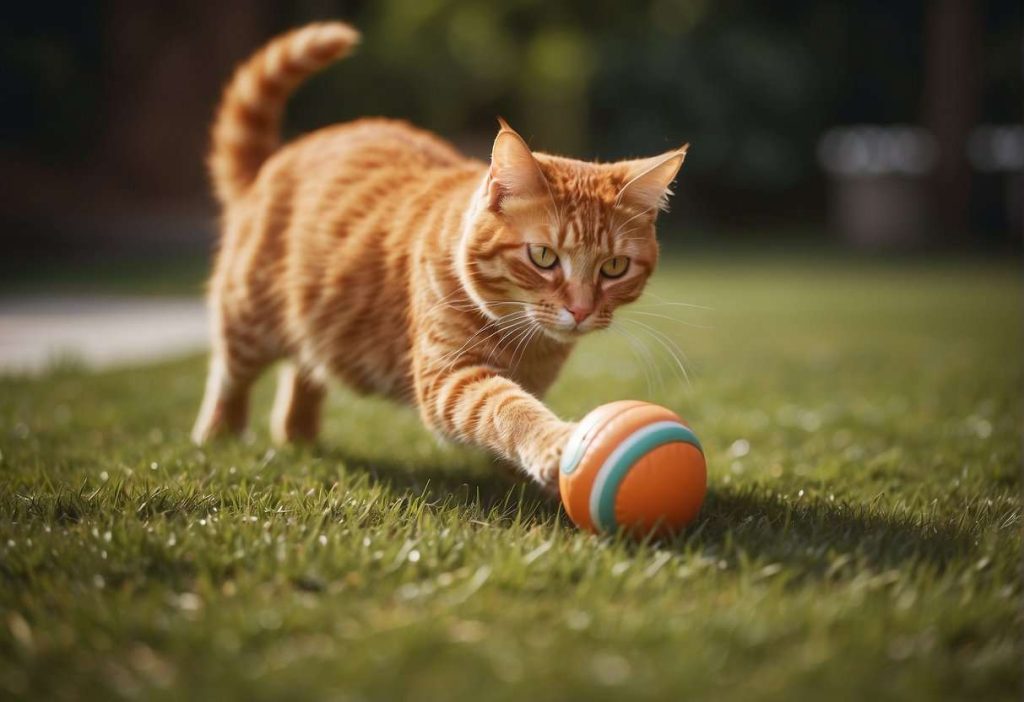
Orange cats, with their striking tabby markings and vibrant coloration, are not just a feast for the eyes; they’re companions that thrive on a strong bond with their humans. Here’s how you can deepen your relationship:
Engage in Interactive Play: Just like catching up over coffee with a friend, playtime is your chance to chat and chuckle with your orange cat.
Use a variety of toys to stimulate their hunter instincts, and watch your bond grow as strong as their pounce.
Understand Their Language: Listen and observe; your tabby is talking to you. The twitch of a tail or a purring symphony can say a lot. When you heed these cues, it’s like learning a secret handshake!
Create a Stress-Free Zone:
- Avoid sudden changes in their environment; cats aren’t fans of surprises.
- Maintain a feeding schedule; consistency is key for your furry pal’s peace of mind.
Remember, stress can have severe implications on health, possibly contributing to issues like obesity or even cancer. Keeping things chill can help avoid these health traps.
Health Matters: Regular vet checkups and obesity prevention are your tickets to a healthy, happy feline. A balanced diet keeps their orange coat shiny and their energy levels optimal.
By honoring their unique nature and avoiding stress triggers, you’ll craft an environment where your bright-colored buddy can flourish.
It’s not just about a happy cat; it’s about a happy you, sharing your world with a purr-fect companion. (5)
Practical Tips for Orange Cat Owners
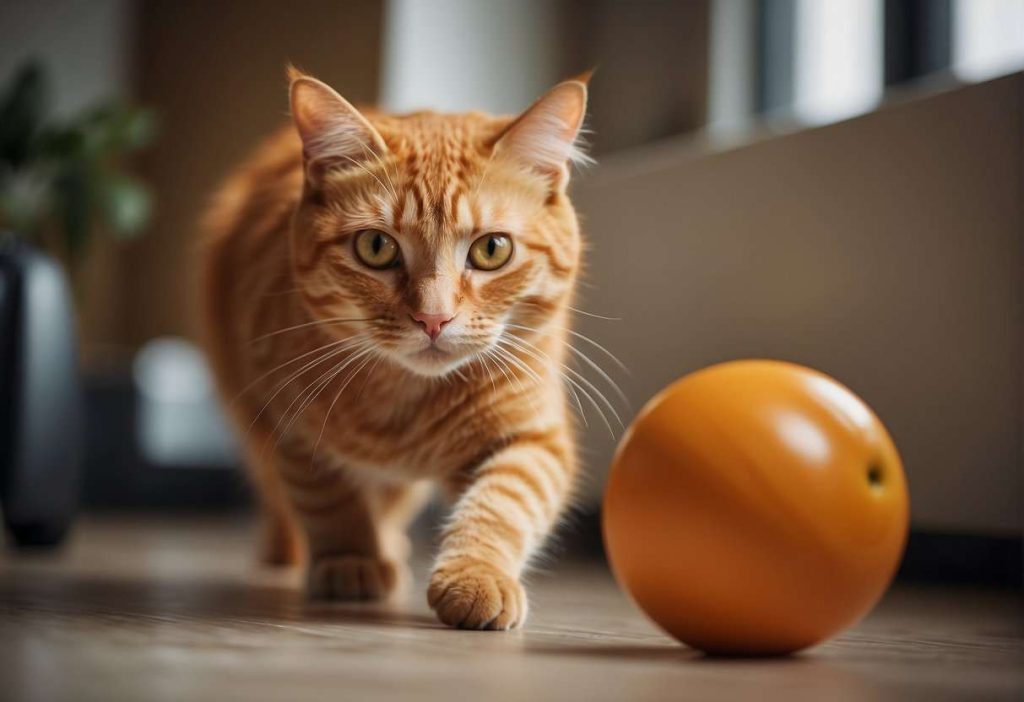
Whether they’re a feisty Maine Coon or a serene Persian, orange cats all share that distinctive red fur and a reputation for ‘cattitude.’ Here’s how you might outsmart the quirks of these often mischievous pets.
Dos and Don’ts in Daily Interactions
- Feeding: Do measure their food, since some cats, like the luxurious Exotic Shorthair, can be prone to overindulgence. Don’t free-feed—establishing a routine prevents overeating.
- Grooming: Persians, with their long, luxurious coats, or even a fluffy American Bobtail, require regular brushing. Do make grooming a bonding experience. Don’t neglect it, or you’ll have a mat situation.
- Play: Tabbies love a good chase. Do engage with interactive toys; it’s their kind of fun. Don’t let them get bored; a bored tabby can become a naughty tabby.
Correcting Behavioral Issues
Scratching furniture or moments of aggression can mar your relationship with your orange buddy. For scratching, do provide a satisfying scratching post; cat trees are the Turkish Angora’s towers of choice.
For moments of feline fury, don’t lash back with anger. Do use toys to redirect their energy, and consider clicker training to reinforce good behavior.
Enhancing Your Cat’s Environment
Creating an enriching environment for your orange feline’s physical and mental well-being is a must.
Do set up perches or window seats, especially if you’re a proud owner of a curious breed like the Turkish Angora.
They love to survey their kingdoms. Don’t forget that puzzles and feeder toys can stimulate their mind, keeping those sharp wits appropriately engaged.
Remember, there’s no one-size-fits-all with cat breeds, not even with the enigmatic orange cats.
Your approach will vary, depending on whether your feline friend struts the sleek lines of an Exotic Shorthair or the bushy tail of an American Bobtail.
But with these tips, you’re on your way to harmoniously living with your fiery-coated friend. (6)
The Joy of Living with Orange Cats

Orange cats, often referred to as ‘ginger’ or ‘marmalade’ cats, are indeed a source of joy and amusement with their distinctive personalities.
They are hugely popular within the United States, as seen through the success of characters like Morris and Garfield.
Let’s talk stereotypes—orange cats come with the reputation of being affectionate clowns. They often exhibit playful and endearing behaviors that can brighten up even the dreariest days. Here’s what you can expect:
- Snuggles: They love to curl up in your lap, offering comfort with their warm presence.
- “Help” Around the House: Whether “assisting” with work or “reorganizing” personal items, orange cats are sure to inject some laughter into your daily routine.
The quirks of these felines aren’t just modern phenomena.
Ancient Egyptians revered all cats, and orange cats might have been among them, catching the eye of humans with their bright coats reminiscent of a desert sunrise.
Here’s a quick list of orange cat joys:
- Personality Plus: With an orange cat, there is never a dull moment. Their antics will leave you giggling.
- Historical Connect: Feel a touch of ancient history with a creature so admired by past civilizations.
- Garfield-Like Wisdom: Orange cats seem to balance laziness with unexpected bursts of energy, much like the beloved cartoon cat.
Do you find yourself chatting with your orange cat as if they’re an old friend? That’s because they’re great listeners.
They might not solve your problems, but they’ll surely make you forget them for a while with a swift pounce on an unsuspecting toy.
Embrace the joy of your ginger pal! With each purr and playful pounce, orange cats remind us not to take life too seriously. After all, isn’t life more fun with a little bit of orange-tinted craziness?
Prioritizing Health and Well-being

Impact of Behavior on Health: Sometimes, what looks like crazy fun might be a signal your cat needs help.
Over-grooming or under-eating might not just be odd habits; they could point to stress or digestive issues. It’s like they’re trying to tell us, “Hey, I might need a check-up here!”
- Excessive scratching or biting can indicate skin conditions.
- Changes in eating habits might reveal dental pain or digestive problems.
- A sudden uptick in “zoomies” could be stress-related.
Quick Tip: Keep an eye on any new or intensified behaviors and chat with your vet! (7)
Creating a Nurturing Environment
Your orange tabby’s environment is their kingdom. Ensuring it’s stimulating and comforting is key for both their mental and physical well-being.
Think climbing trees for exercise, puzzle feeders for brain games, and cozy hideouts for stress-free naps.
Mental and Physical Health Tips:
- Nutrition: Select high-quality cat food rich in protein. Remember, your cat is a food lover with a taste for the good stuff.
- Exercise: Interactive toys can keep your energetic buddy engaged.
- Grooming: Brush your cat regularly to keep their fiery coat in top condition.
Stress Reduction Techniques:
- Keeping a consistent routine.
- Introducing new pets or people slowly, so they don’t lose their cool.
- Offering plenty of love and playtime—it’s like hitting the refresh button on their mood!
Remember to keep your home a happy, cat-friendly place, and those “crazy” antics might just simmer down into content purrs.
Quick Recap
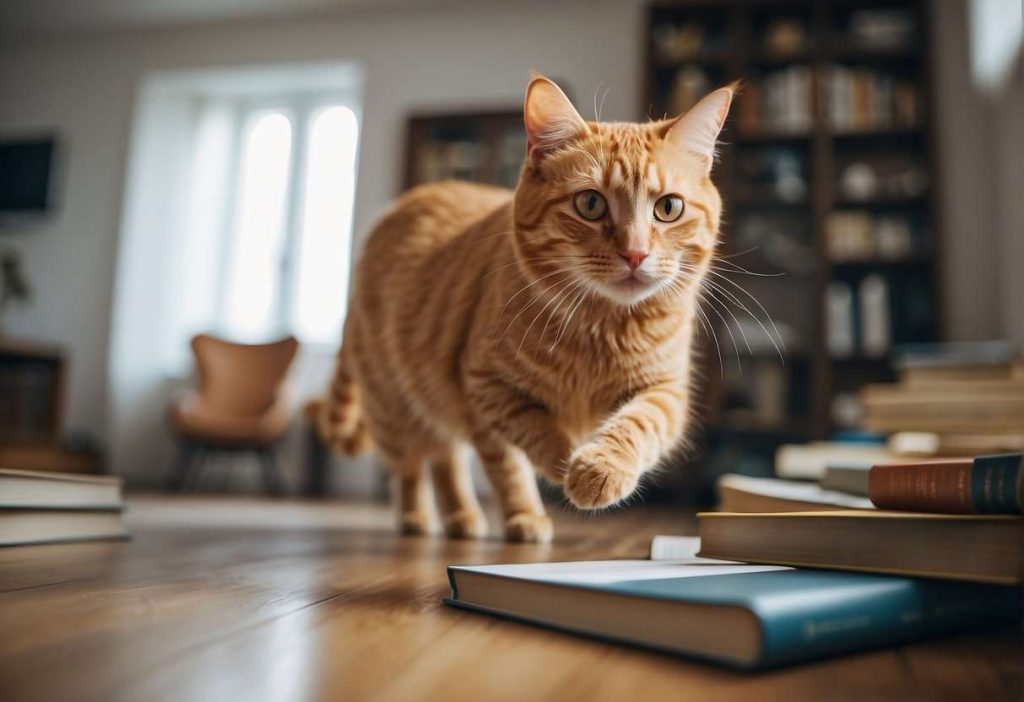
Genetics: While that striking orange fur comes from their “O” genes, behavior’s not bundled in that same genetic package.
So, don’t expect Mr. Whiskers to act out the ‘crazy orange cat’ stereotype just because of his coat color.
Behavioral Traits: Yes, you might notice your furry friend displaying a mix of affectionate and territorial tendencies.
They could surprise you with a cuddle or assert dominance with a bit of a scratch marathon on your new sofa.
- Affectionate gestures: These cuties may knead their paws or cozy up with you, which means they’re comfortable in their environment.
- Territorial habits: Expect some marking—cats by nature might just decide that your favorite rug needs a personal stamp.
Myth-Busting: Feel free to dismiss that old wives’ tale linking orange fur to wacky antics. Your orange cat’s behavior is more shaped by its environment and upbringing.
Remember, each cat is an individual, so your interaction and care matter. Nurturing your bond with your ginger companion ensures both of you enjoy a harmonious life together.
Cherish those special idiosyncrasies – they make your time with your orange cat uniquely delightful.
Frequently Asked Questions
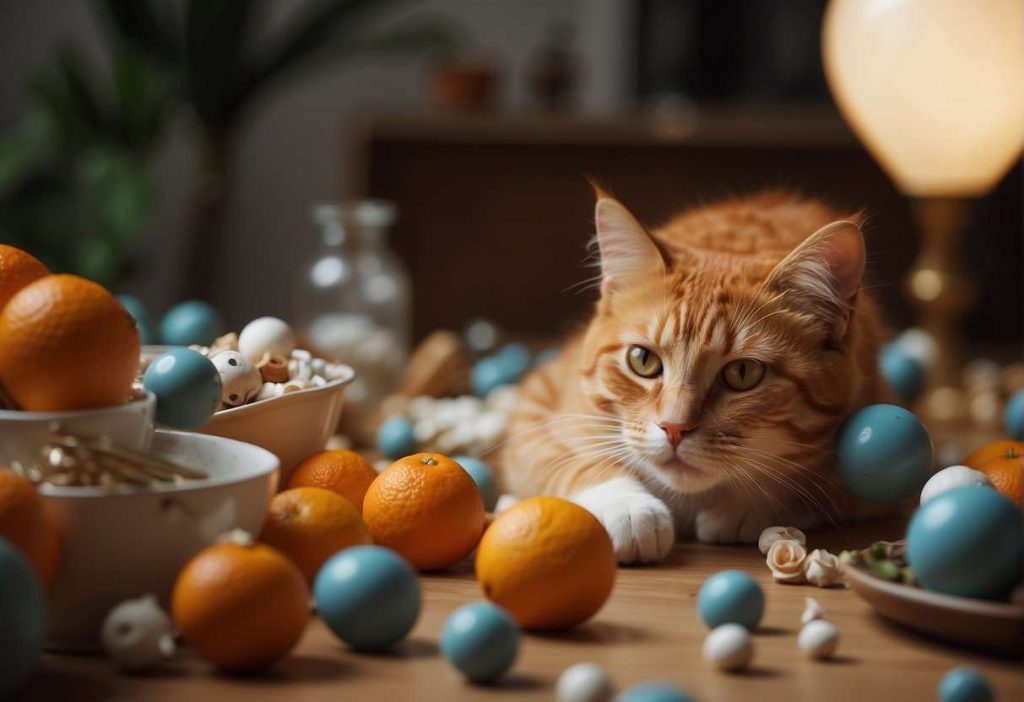
Curious about your quirky orange feline? You’re not alone! Here’s the scoop on the peculiar behaviors often displayed by orange cats and some tips to strengthen your bond with your ginger companion.
Why do orange cats have a reputation for being “crazy”?
You might have heard the chatter about orange cats being a bit more rambunctious than the rest.
It’s likely due to popular internet stereotypes that have gained traction, painting these ginger kitties as chaotic but lovable furballs.
Can the behavior of orange cats indicate their health and well-being?
Absolutely! While orange cats are known for their playful antics, changes in behavior can clue you in on their mood or health.
Always stay observant, as excessive shenanigans might warrant a check-up.
How can I improve my relationship with my orange cat?
Building rapport with your orange cat can be a fun adventure. Engage with toys, provide cozy nap spots, and set a routine for playtime and cuddles.
They’ll often reciprocate with purrs and kneading—a sure sign of a content cat.
What are some common misconceptions about orange cats?
One common myth is that the orange fur gene affects behavior. However, there’s no scientific evidence correlating fur color with personality traits.
Orange cats are just as diverse as any other color!
Are orange cats more affectionate and friendly than other cats?
The rumor mill suggests that orange cats are known for being more affectionate. While they can be very loving, remember that every cat is an individual.
Your mile may vary, but don’t you just love their cuddly surprises?
What practical tips can help me address behavioral issues in my orange cat?
To curb any unwanted behaviors, focus on consistency.
Use positive reinforcement when they exhibit good behavior and create an enriching environment to satisfy their curiosity. Remember, patience goes a long way!
- The Ultimate Overview to Actual Cash Gambling Establishments - July 1, 2025


